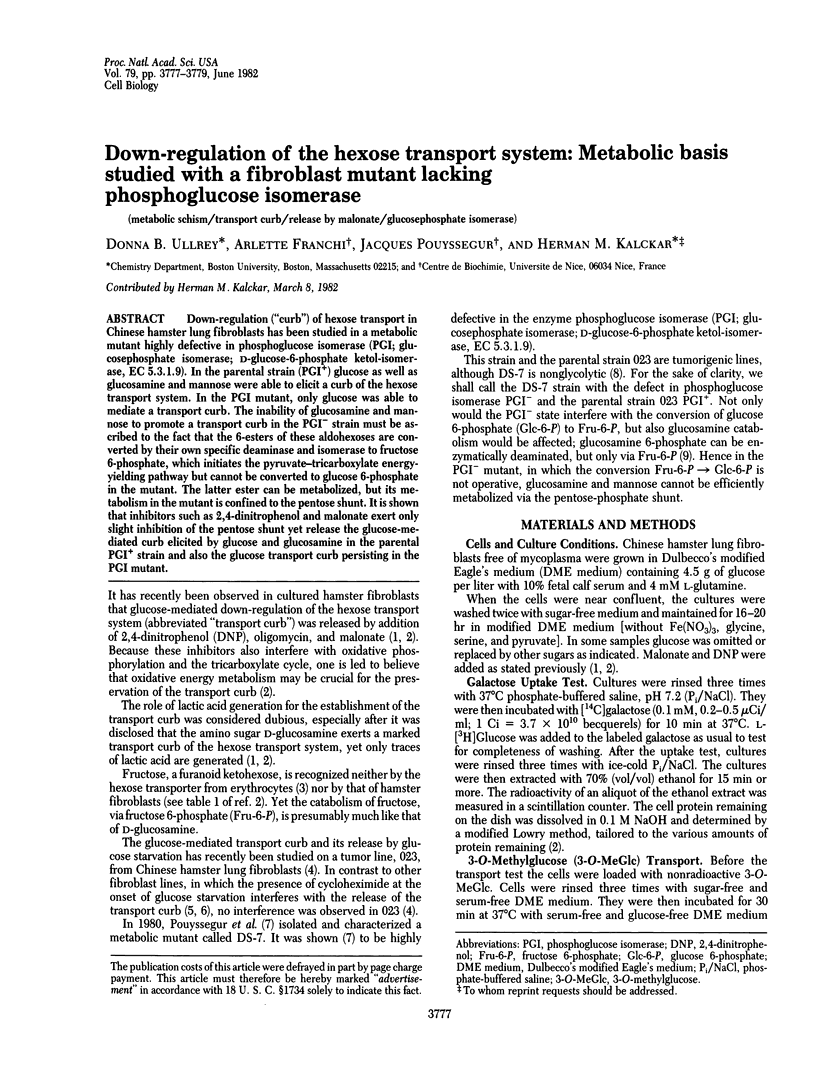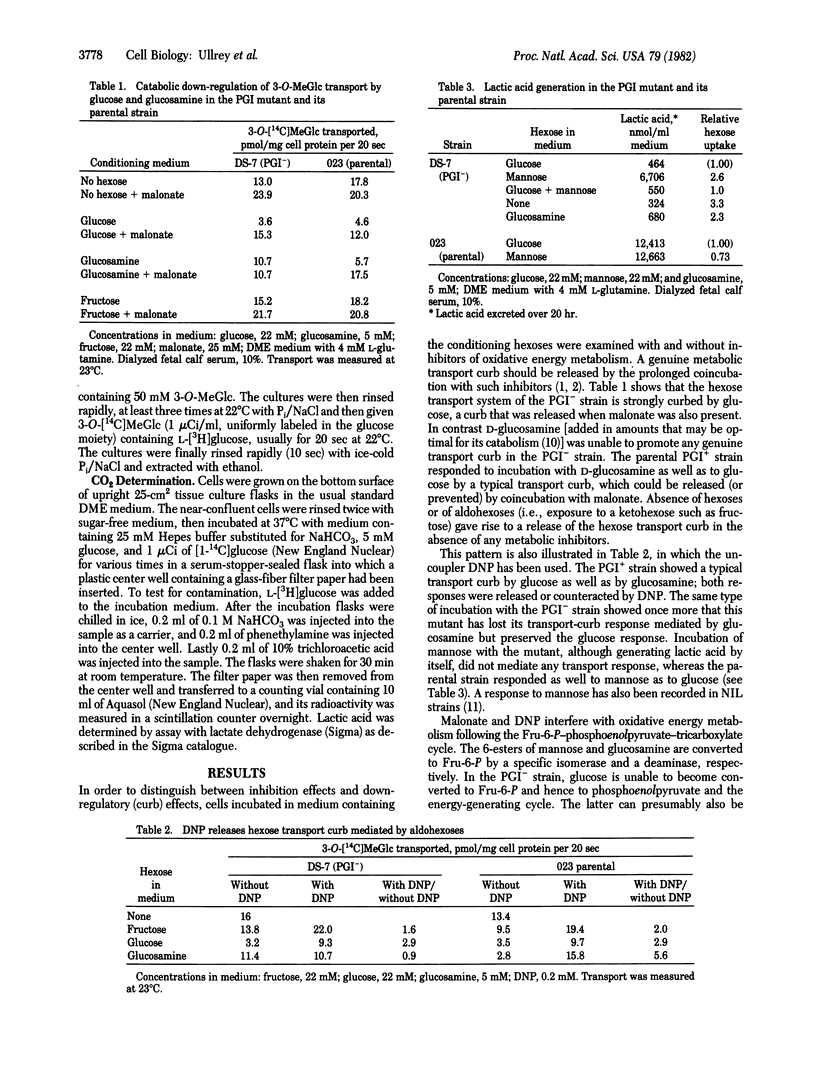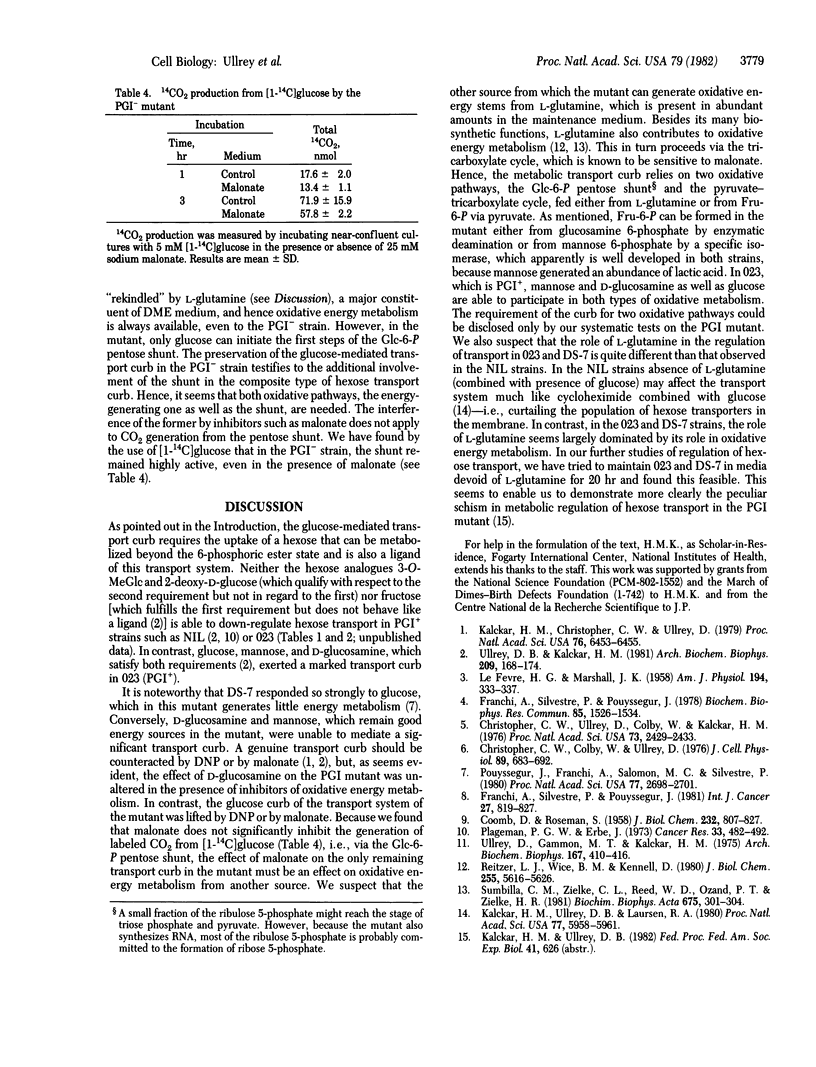Abstract
Down-regulation ("curb") of hexose transport in Chinese hamster lung fibroblasts has been studied in a metabolic mutant highly defective in phosphoglucose isomerase (PGI; glucosephosphate isomerase; D-glucose-6-phosphate ketol-isomerase, EC 5.3.1.9). In the parental strain (PGI+) glucose as well as glucosamine and mannose were able to elicit a curb of the hexose transport system. In the PGI mutant, only glucose was able to mediate a transport curb. The inability of glucosamine and mannose to promote a transport curb in the PGI strain must be ascribed to the fact that the 6-esters of these aldohexoses are converted by their own specific deaminase and isomerase to fructose 6-phosphate, which initiates the pyruvate-tricarboxylate energy-yielding pathway but cannot be converted to glucose 6-phosphate in the mutant. The latter ester can be metabolized, but its metabolism in the mutant is confined to the pentose shunt. It is shown that inhibitors such as 2,4-dinitrophenol and malonate exert only slight inhibition of the pentose shunt yet release the glucose-mediated curb elicited by glucose and glucosamine in the parental PGI+ strain and also the glucose transport curb persisting in the PGI mutant.
Full text
PDF


Selected References
These references are in PubMed. This may not be the complete list of references from this article.
- COMB D. G., ROSEMAN S. Glucosamine metabolism. IV. Glucosamine-6-phosphate deaminase. J Biol Chem. 1958 Jun;232(2):807–827. [PubMed] [Google Scholar]
- Christopher C. W., Colby W. W., Ullrey D. Derepression and carrier turnover: evidence for two distinct mechanisms of hexose transport regulation in animal cells. J Cell Physiol. 1976 Dec;89(4):683–692. doi: 10.1002/jcp.1040890427. [DOI] [PubMed] [Google Scholar]
- Christopher C. W., Ullrey D., Colby W., Kalckar M. Paradoxical effects of cycloheximide and cytochalasin B on hamster cell hexose uptake. Proc Natl Acad Sci U S A. 1976 Jul;73(7):2429–2433. doi: 10.1073/pnas.73.7.2429. [DOI] [PMC free article] [PubMed] [Google Scholar]
- Franchi A., Silvestre P., Pouyssegur J. "Carrier activation" and glucose transport in Chinese hamster fibroblasts. Biochem Biophys Res Commun. 1978 Dec 29;85(4):1526–1534. doi: 10.1016/0006-291x(78)91176-2. [DOI] [PubMed] [Google Scholar]
- Franchi A., Silvestre P., Pouysségur J. A genetic approach to the role of energy metabolism in the growth of tumor cells: tumorigenicity of fibroblast mutants deficient either in glycolysis or in respiration. Int J Cancer. 1981 Jun 15;27(6):819–827. doi: 10.1002/ijc.2910270614. [DOI] [PubMed] [Google Scholar]
- Kalckar H. M., Christopher C. W., Ullrey D. Uncouplers of oxidative phosphorylation promote derepression of the hexose transport system in cultures of hamster cells. Proc Natl Acad Sci U S A. 1979 Dec;76(12):6453–6455. doi: 10.1073/pnas.76.12.6453. [DOI] [PMC free article] [PubMed] [Google Scholar]
- Kalckar H. M., Ullrey D. B., Laursen R. A. Effects of combined glutamine and serum deprivation on glucose control of hexose transport in mammalian fibroblast cultures. Proc Natl Acad Sci U S A. 1980 Oct;77(10):5958–5961. doi: 10.1073/pnas.77.10.5958. [DOI] [PMC free article] [PubMed] [Google Scholar]
- LEFEVRE P. G., MARSHALL J. K. Conformational specificity in a biological sugar transport system. Am J Physiol. 1958 Aug;194(2):333–337. doi: 10.1152/ajplegacy.1958.194.2.333. [DOI] [PubMed] [Google Scholar]
- Plagemann P. G., Erbe J. Transport and metabolism of glucosamine by cultured Novikoff rat hepatoma cells and effects on nucleotide pools. Cancer Res. 1973 Mar;33(3):482–492. [PubMed] [Google Scholar]
- Pouysségur J., Franchi A., Salomon J. C., Silvestre P. Isolation of a Chinese hamster fibroblast mutant defective in hexose transport and aerobic glycolysis: its use to dissect the malignant phenotype. Proc Natl Acad Sci U S A. 1980 May;77(5):2698–2701. doi: 10.1073/pnas.77.5.2698. [DOI] [PMC free article] [PubMed] [Google Scholar]
- Reitzer L. J., Wice B. M., Kennell D. The pentose cycle. Control and essential function in HeLa cell nucleic acid synthesis. J Biol Chem. 1980 Jun 25;255(12):5616–5626. [PubMed] [Google Scholar]
- Sumbilla C. M., Zielke C. L., Reed W. D., Ozand P. T., Zielke H. R. Comparison of the oxidation of glutamine, glucose, ketone bodies and fatty acids by human diploid fibroblasts. Biochim Biophys Acta. 1981 Jul;675(2):301–304. doi: 10.1016/0304-4165(81)90242-7. [DOI] [PubMed] [Google Scholar]
- Ullrey D. B., Kalckar H. M. The nature of regulation of hexose transport in cultured mammalian fibroblasts: aerobic "repressive" control by D-glucosamine. Arch Biochem Biophys. 1981 Jun;209(1):168–174. doi: 10.1016/0003-9861(81)90269-1. [DOI] [PubMed] [Google Scholar]
- Ullrey D., Gammon M. T., Kalckar H. M. Uptake patterns and transport enhancements in cultures of hamster cells deprived of carbohydrates. Arch Biochem Biophys. 1975 Apr;167(2):410–416. doi: 10.1016/0003-9861(75)90481-6. [DOI] [PubMed] [Google Scholar]


